traction control SATURN ION 2007 Owners Manual
[x] Cancel search | Manufacturer: SATURN, Model Year: 2007, Model line: ION, Model: SATURN ION 2007Pages: 440, PDF Size: 2.93 MB
Page 138 of 440
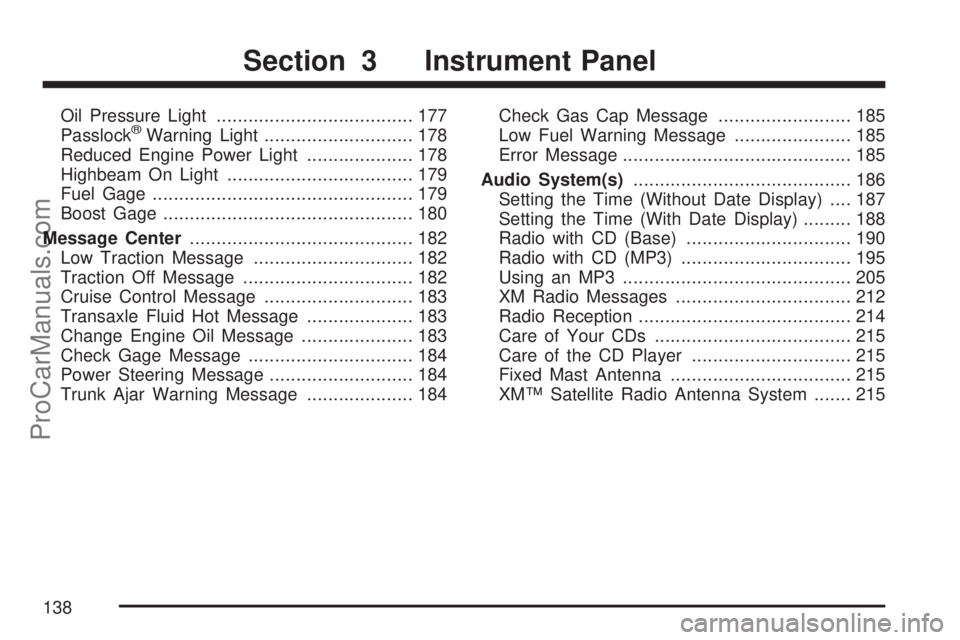
Oil Pressure Light..................................... 177
Passlock®Warning Light............................ 178
Reduced Engine Power Light.................... 178
Highbeam On Light................................... 179
Fuel Gage................................................. 179
Boost Gage............................................... 180
Message Center.......................................... 182
Low Traction Message.............................. 182
Traction Off Message................................ 182
Cruise Control Message............................ 183
Transaxle Fluid Hot Message.................... 183
Change Engine Oil Message..................... 183
Check Gage Message............................... 184
Power Steering Message........................... 184
Trunk Ajar Warning Message.................... 184Check Gas Cap Message......................... 185
Low Fuel Warning Message...................... 185
Error Message........................................... 185
Audio System(s)......................................... 186
Setting the Time (Without Date Display).... 187
Setting the Time (With Date Display)......... 188
Radio with CD (Base)............................... 190
Radio with CD (MP3)................................ 195
Using an MP3........................................... 205
XM Radio Messages................................. 212
Radio Reception........................................ 214
Care of Your CDs..................................... 215
Care of the CD Player.............................. 215
Fixed Mast Antenna.................................. 215
XM™ Satellite Radio Antenna System....... 215
Section 3 Instrument Panel
138
ProCarManuals.com
Page 141 of 440
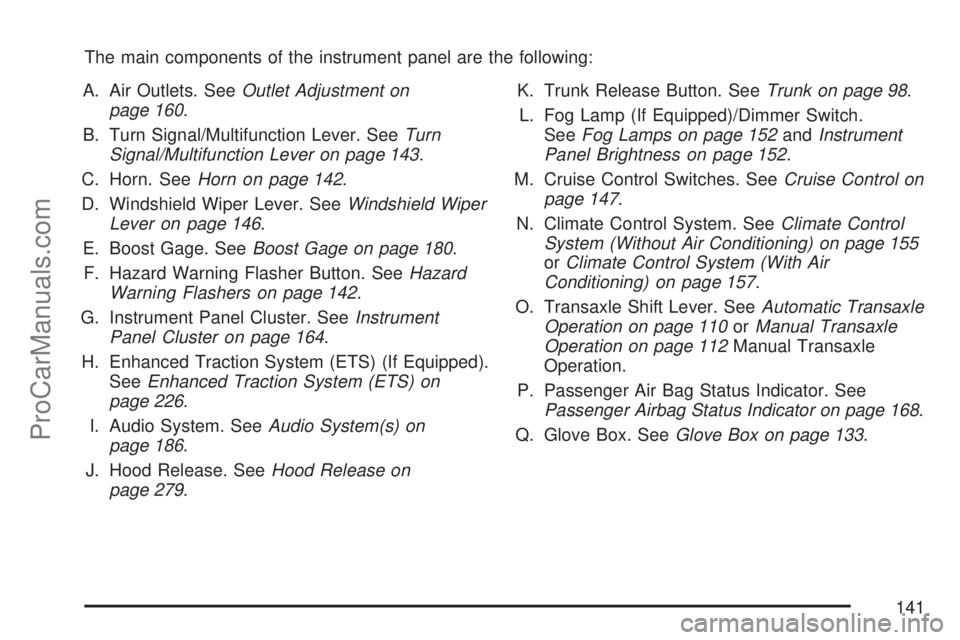
The main components of the instrument panel are the following:
A. Air Outlets. SeeOutlet Adjustment on
page 160.
B. Turn Signal/Multifunction Lever. SeeTurn
Signal/Multifunction Lever on page 143.
C. Horn. SeeHorn on page 142.
D. Windshield Wiper Lever. SeeWindshield Wiper
Lever on page 146.
E. Boost Gage. SeeBoost Gage on page 180.
F. Hazard Warning Flasher Button. SeeHazard
Warning Flashers on page 142.
G. Instrument Panel Cluster. SeeInstrument
Panel Cluster on page 164.
H. Enhanced Traction System (ETS) (If Equipped).
SeeEnhanced Traction System (ETS) on
page 226.
I. Audio System. SeeAudio System(s) on
page 186.
J. Hood Release. SeeHood Release on
page 279.K. Trunk Release Button. SeeTrunk on page 98.
L. Fog Lamp (If Equipped)/Dimmer Switch.
SeeFog Lamps on page 152andInstrument
Panel Brightness on page 152.
M. Cruise Control Switches. SeeCruise Control on
page 147.
N. Climate Control System. SeeClimate Control
System (Without Air Conditioning) on page 155
orClimate Control System (With Air
Conditioning) on page 157.
O. Transaxle Shift Lever. SeeAutomatic Transaxle
Operation on page 110orManual Transaxle
Operation on page 112Manual Transaxle
Operation.
P. Passenger Air Bag Status Indicator. See
Passenger Airbag Status Indicator on page 168.
Q. Glove Box. SeeGlove Box on page 133.
141
ProCarManuals.com
Page 147 of 440
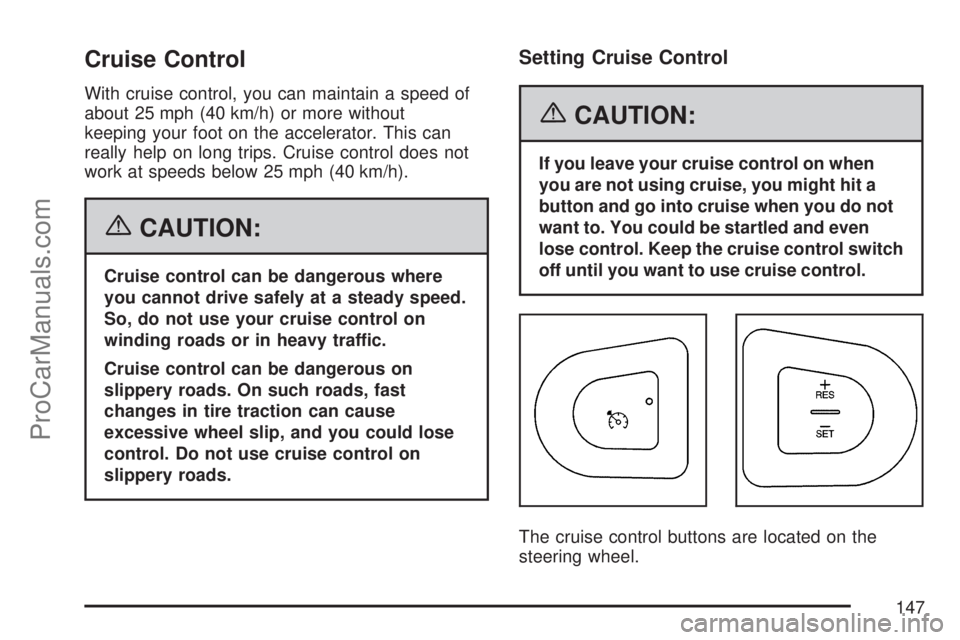
Cruise Control
With cruise control, you can maintain a speed of
about 25 mph (40 km/h) or more without
keeping your foot on the accelerator. This can
really help on long trips. Cruise control does not
work at speeds below 25 mph (40 km/h).
{CAUTION:
Cruise control can be dangerous where
you cannot drive safely at a steady speed.
So, do not use your cruise control on
winding roads or in heavy traffic.
Cruise control can be dangerous on
slippery roads. On such roads, fast
changes in tire traction can cause
excessive wheel slip, and you could lose
control. Do not use cruise control on
slippery roads.
Setting Cruise Control
{CAUTION:
If you leave your cruise control on when
you are not using cruise, you might hit a
button and go into cruise when you do not
want to. You could be startled and even
lose control. Keep the cruise control switch
off until you want to use cruise control.
The cruise control buttons are located on the
steering wheel.
147
ProCarManuals.com
Page 148 of 440
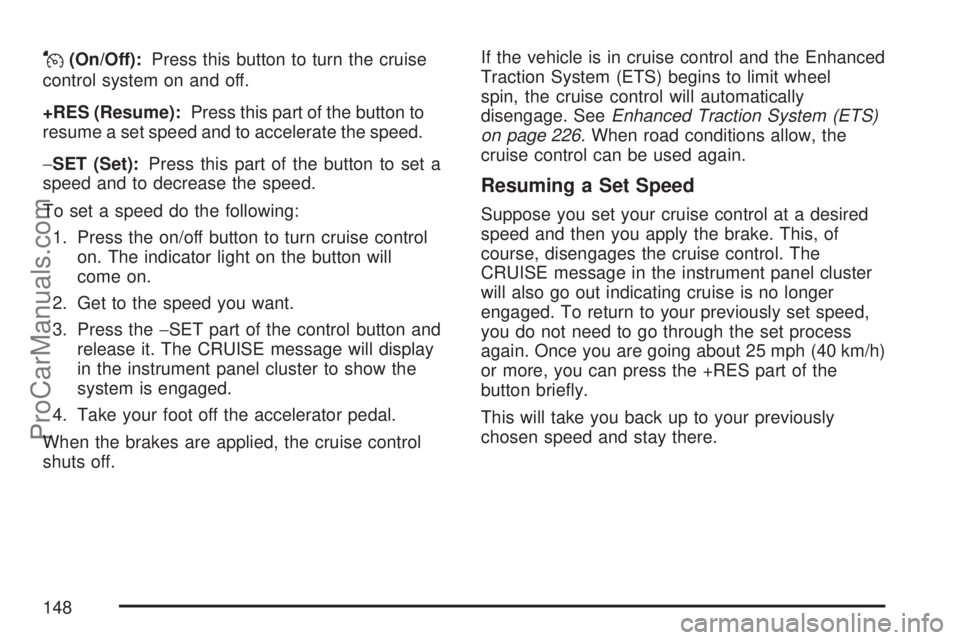
J(On/Off):Press this button to turn the cruise
control system on and off.
+RES (Resume):Press this part of the button to
resume a set speed and to accelerate the speed.
−SET (Set):Press this part of the button to set a
speed and to decrease the speed.
To set a speed do the following:
1. Press the on/off button to turn cruise control
on. The indicator light on the button will
come on.
2. Get to the speed you want.
3. Press the−SET part of the control button and
release it. The CRUISE message will display
in the instrument panel cluster to show the
system is engaged.
4. Take your foot off the accelerator pedal.
When the brakes are applied, the cruise control
shuts off.If the vehicle is in cruise control and the Enhanced
Traction System (ETS) begins to limit wheel
spin, the cruise control will automatically
disengage. SeeEnhanced Traction System (ETS)
on page 226. When road conditions allow, the
cruise control can be used again.
Resuming a Set Speed
Suppose you set your cruise control at a desired
speed and then you apply the brake. This, of
course, disengages the cruise control. The
CRUISE message in the instrument panel cluster
will also go out indicating cruise is no longer
engaged. To return to your previously set speed,
you do not need to go through the set process
again. Once you are going about 25 mph (40 km/h)
or more, you can press the +RES part of the
button brie�y.
This will take you back up to your previously
chosen speed and stay there.
148
ProCarManuals.com
Page 186 of 440
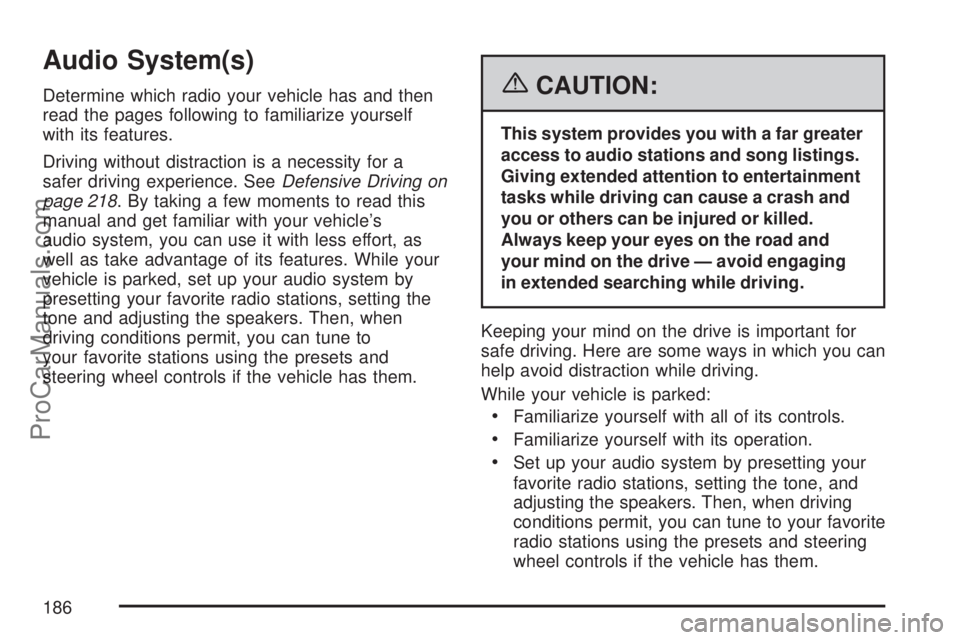
Audio System(s)
Determine which radio your vehicle has and then
read the pages following to familiarize yourself
with its features.
Driving without distraction is a necessity for a
safer driving experience. SeeDefensive Driving on
page 218. By taking a few moments to read this
manual and get familiar with your vehicle’s
audio system, you can use it with less effort, as
well as take advantage of its features. While your
vehicle is parked, set up your audio system by
presetting your favorite radio stations, setting the
tone and adjusting the speakers. Then, when
driving conditions permit, you can tune to
your favorite stations using the presets and
steering wheel controls if the vehicle has them.{CAUTION:
This system provides you with a far greater
access to audio stations and song listings.
Giving extended attention to entertainment
tasks while driving can cause a crash and
you or others can be injured or killed.
Always keep your eyes on the road and
your mind on the drive — avoid engaging
in extended searching while driving.
Keeping your mind on the drive is important for
safe driving. Here are some ways in which you can
help avoid distraction while driving.
While your vehicle is parked:
Familiarize yourself with all of its controls.
Familiarize yourself with its operation.
Set up your audio system by presetting your
favorite radio stations, setting the tone, and
adjusting the speakers. Then, when driving
conditions permit, you can tune to your favorite
radio stations using the presets and steering
wheel controls if the vehicle has them.
186
ProCarManuals.com
Page 217 of 440
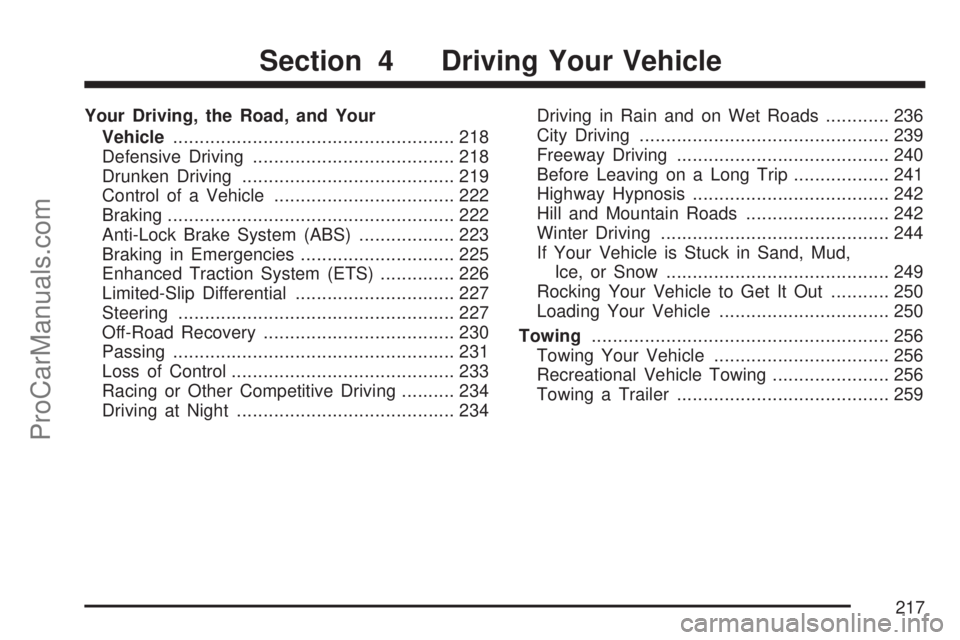
Your Driving, the Road, and Your
Vehicle..................................................... 218
Defensive Driving...................................... 218
Drunken Driving........................................ 219
Control of a Vehicle.................................. 222
Braking...................................................... 222
Anti-Lock Brake System (ABS).................. 223
Braking in Emergencies............................. 225
Enhanced Traction System (ETS).............. 226
Limited-Slip Differential.............................. 227
Steering.................................................... 227
Off-Road Recovery.................................... 230
Passing..................................................... 231
Loss of Control.......................................... 233
Racing or Other Competitive Driving.......... 234
Driving at Night......................................... 234Driving in Rain and on Wet Roads............ 236
City Driving............................................... 239
Freeway Driving........................................ 240
Before Leaving on a Long Trip.................. 241
Highway Hypnosis..................................... 242
Hill and Mountain Roads........................... 242
Winter Driving........................................... 244
If Your Vehicle is Stuck in Sand, Mud,
Ice, or Snow.......................................... 249
Rocking Your Vehicle to Get It Out........... 250
Loading Your Vehicle................................ 250
Towing........................................................ 256
Towing Your Vehicle ................................. 256
Recreational Vehicle Towing...................... 256
Towing a Trailer........................................ 259
Section 4 Driving Your Vehicle
217
ProCarManuals.com
Page 222 of 440

Control of a Vehicle
You have three systems that make your vehicle go
where you want it to go. They are the brakes, the
steering, and the accelerator. All three systems
have to do their work at the places where the tires
meet the road.
Sometimes, as when you are driving on snow or
ice, it is easy to ask more of those control systems
than the tires and road can provide. That means
you can lose control of your vehicle. See
Enhanced Traction System (ETS) on page 226.
Adding non-Saturn accessories can affect
your vehicle’s performance. SeeAccessories and
Modi�cations on page 270.
Braking
SeeBrake System Warning Light on page 170.
Braking action involves perception time and
reaction time.
First, you have to decide to push on the brake
pedal. That is perception time. Then you have to
bring up your foot and do it. That is reaction time.Average reaction time is about three-fourths of a
second. But that is only an average. It might
be less with one driver and as long as two or
three seconds or more with another. Age, physical
condition, alertness, coordination, and eyesight
all play a part. So do alcohol, drugs, and
frustration. But even in three-fourths of a second,
a vehicle moving at 60 mph (100 km/h) travels
66 feet (20 m). That could be a lot of distance in an
emergency, so keeping enough space between
your vehicle and others is important.
And, of course, actual stopping distances vary
greatly with the surface of the road, whether it is
pavement or gravel; the condition of the road,
whether it is wet, dry, or icy; tire tread; the condition
of the brakes; the weight of the vehicle; and the
amount of brake force applied.
222
ProCarManuals.com
Page 226 of 440
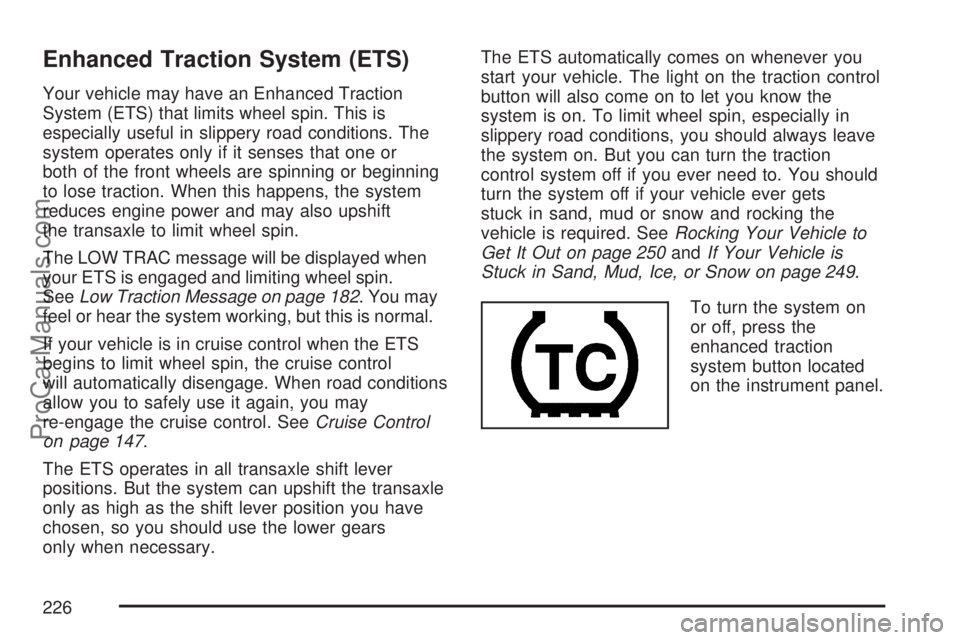
Enhanced Traction System (ETS)
Your vehicle may have an Enhanced Traction
System (ETS) that limits wheel spin. This is
especially useful in slippery road conditions. The
system operates only if it senses that one or
both of the front wheels are spinning or beginning
to lose traction. When this happens, the system
reduces engine power and may also upshift
the transaxle to limit wheel spin.
The LOW TRAC message will be displayed when
your ETS is engaged and limiting wheel spin.
SeeLow Traction Message on page 182. You may
feel or hear the system working, but this is normal.
If your vehicle is in cruise control when the ETS
begins to limit wheel spin, the cruise control
will automatically disengage. When road conditions
allow you to safely use it again, you may
re-engage the cruise control. SeeCruise Control
on page 147.
The ETS operates in all transaxle shift lever
positions. But the system can upshift the transaxle
only as high as the shift lever position you have
chosen, so you should use the lower gears
only when necessary.The ETS automatically comes on whenever you
start your vehicle. The light on the traction control
button will also come on to let you know the
system is on. To limit wheel spin, especially in
slippery road conditions, you should always leave
the system on. But you can turn the traction
control system off if you ever need to. You should
turn the system off if your vehicle ever gets
stuck in sand, mud or snow and rocking the
vehicle is required. SeeRocking Your Vehicle to
Get It Out on page 250andIf Your Vehicle is
Stuck in Sand, Mud, Ice, or Snow on page 249.
To turn the system on
or off, press the
enhanced traction
system button located
on the instrument panel.
226
ProCarManuals.com
Page 228 of 440
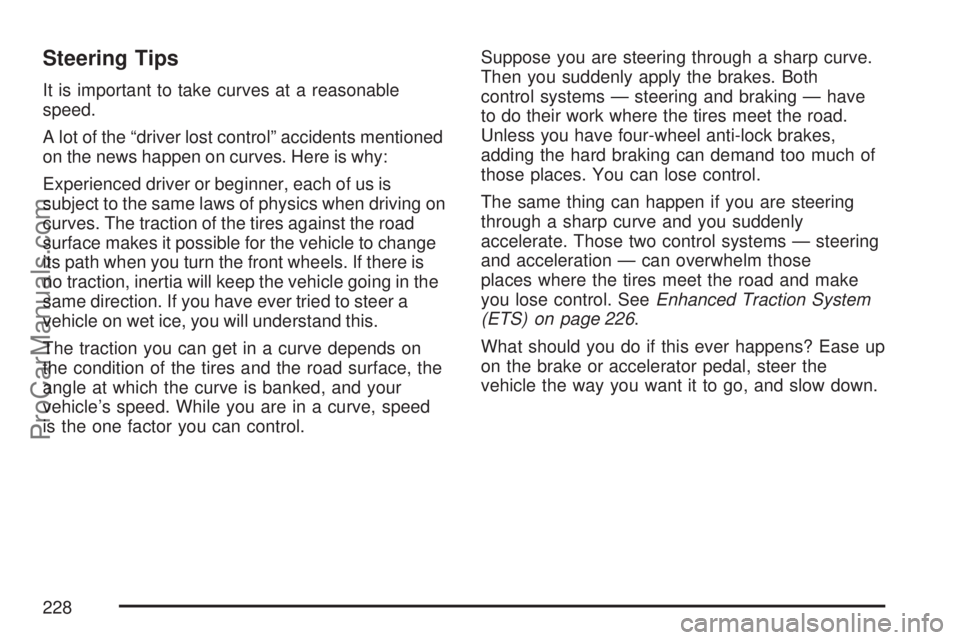
Steering Tips
It is important to take curves at a reasonable
speed.
A lot of the “driver lost control” accidents mentioned
on the news happen on curves. Here is why:
Experienced driver or beginner, each of us is
subject to the same laws of physics when driving on
curves. The traction of the tires against the road
surface makes it possible for the vehicle to change
its path when you turn the front wheels. If there is
no traction, inertia will keep the vehicle going in the
same direction. If you have ever tried to steer a
vehicle on wet ice, you will understand this.
The traction you can get in a curve depends on
the condition of the tires and the road surface, the
angle at which the curve is banked, and your
vehicle’s speed. While you are in a curve, speed
is the one factor you can control.Suppose you are steering through a sharp curve.
Then you suddenly apply the brakes. Both
control systems — steering and braking — have
to do their work where the tires meet the road.
Unless you have four-wheel anti-lock brakes,
adding the hard braking can demand too much of
those places. You can lose control.
The same thing can happen if you are steering
through a sharp curve and you suddenly
accelerate. Those two control systems — steering
and acceleration — can overwhelm those
places where the tires meet the road and make
you lose control. SeeEnhanced Traction System
(ETS) on page 226.
What should you do if this ever happens? Ease up
on the brake or accelerator pedal, steer the
vehicle the way you want it to go, and slow down.
228
ProCarManuals.com
Page 233 of 440
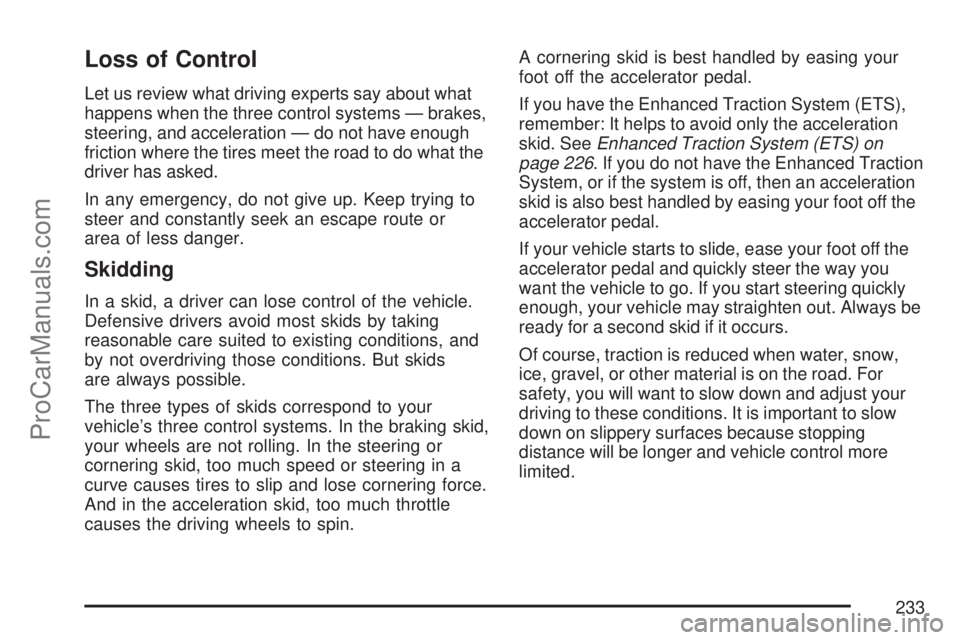
Loss of Control
Let us review what driving experts say about what
happens when the three control systems — brakes,
steering, and acceleration — do not have enough
friction where the tires meet the road to do what the
driver has asked.
In any emergency, do not give up. Keep trying to
steer and constantly seek an escape route or
area of less danger.
Skidding
In a skid, a driver can lose control of the vehicle.
Defensive drivers avoid most skids by taking
reasonable care suited to existing conditions, and
by not overdriving those conditions. But skids
are always possible.
The three types of skids correspond to your
vehicle’s three control systems. In the braking skid,
your wheels are not rolling. In the steering or
cornering skid, too much speed or steering in a
curve causes tires to slip and lose cornering force.
And in the acceleration skid, too much throttle
causes the driving wheels to spin.A cornering skid is best handled by easing your
foot off the accelerator pedal.
If you have the Enhanced Traction System (ETS),
remember: It helps to avoid only the acceleration
skid. SeeEnhanced Traction System (ETS) on
page 226. If you do not have the Enhanced Traction
System, or if the system is off, then an acceleration
skid is also best handled by easing your foot off the
accelerator pedal.
If your vehicle starts to slide, ease your foot off the
accelerator pedal and quickly steer the way you
want the vehicle to go. If you start steering quickly
enough, your vehicle may straighten out. Always be
ready for a second skid if it occurs.
Of course, traction is reduced when water, snow,
ice, gravel, or other material is on the road. For
safety, you will want to slow down and adjust your
driving to these conditions. It is important to slow
down on slippery surfaces because stopping
distance will be longer and vehicle control more
limited.
233
ProCarManuals.com